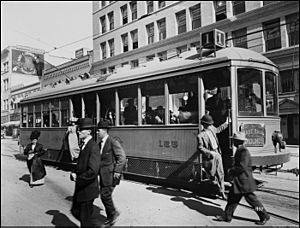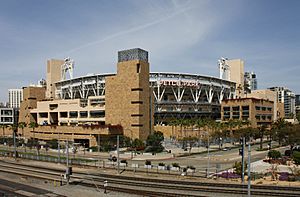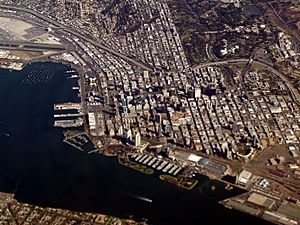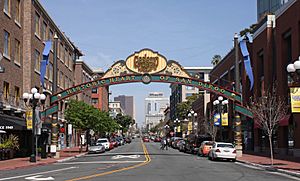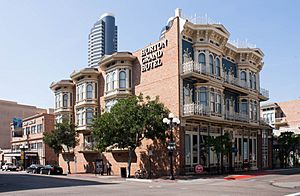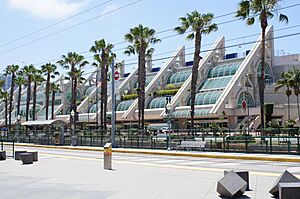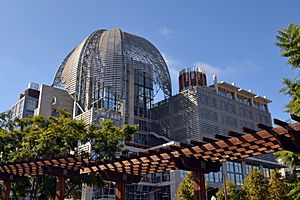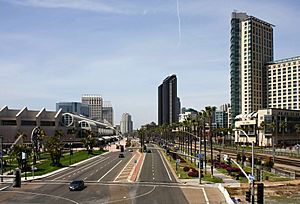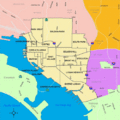Downtown San Diego facts for kids
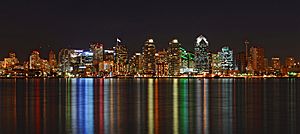
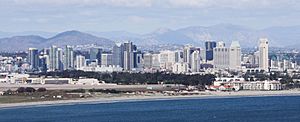
Downtown San Diego is the main downtown area of San Diego, California. San Diego is the eighth largest city in the United States. This area is where the main offices for the city, county, state, and federal governments are located. Downtown San Diego has seven different neighborhoods: Gaslamp Quarter, East Village, Columbia, Marina, Cortez Hill, Little Italy, and Core.
The San Diego Convention Center, which is the city's main place for big meetings and events, is in Downtown San Diego. It's also home to the San Diego Symphony and the San Diego Opera. You can find many places for shows and performances here, like Jacobs Music Center, the Rady Shell at Jacobs Park, and the San Diego Civic Theatre.
Downtown San Diego is right on San Diego Bay. Here, you can visit the USS Midway Museum and the Maritime Museum of San Diego. Balboa Park, a large city park with lots of culture, is right next to downtown. The San Diego International Airport is only about 3 miles (4.8 km) northwest of downtown.
Contents
History of Downtown San Diego
The first city of San Diego was in Old Town, near the Presidio. This was several miles north of where Downtown San Diego is today. This spot wasn't great because it was far from the water, which made trade difficult.
Early Beginnings
In 1849, a surveyor named Lt. Andrew B. Gray thought a spot closer to San Diego Bay would be better for a city. He believed it would be much better for trade. He shared his idea with William Heath Davis, who then found four other people to invest. Together, they bought 160 acres of land where Downtown San Diego is now. They planned out streets for this "New Town" and built a dock and a warehouse. Some people even built houses there, including the William Heath Davis House, which is still a museum today.
However, New Town didn't do well at first. There wasn't enough fresh water, and a money problem hit in 1851. Also, the older towns of Old Town and La Playa didn't want New Town to succeed.
Alonzo Horton's Vision
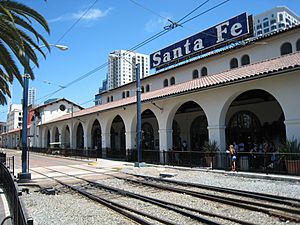
In 1867, Alonzo Horton bought 800 acres of land in the current Downtown area. In 1869, he added Davis's 160 acres to his property. This area became known as the Horton Addition. Davis's old dock was broken, but Horton knew the area was still perfect for a harbor. He built a new dock at the end of Fifth Avenue in 1869.
Horton worked hard to sell land and even gave some away to encourage building. This started San Diego's first big real estate boom. Many people moved to this "New Town" because it had better access to shipping. In 1871, government records were moved to a new county courthouse in New Town. By the 1880s, New Town had become the main part of the growing city, completely taking over from Old Town.
Growth and Modernization
In 1885, the transcontinental railroad reached San Diego. The Santa Fe train station opened downtown in 1887. This station was later replaced in 1915 by the famous Santa Fe Depot, which is still used today. In 1886, New Town got its first electric lights and its first streetcars. The Spreckels Theater opened downtown in 1912. It was the first modern theater west of the Mississippi River. A new commercial dock, the Broadway Pier, was built by the city in 1913.
In the 1910s, Downtown San Diego became connected by Class 1 streetcars. This large public transportation system was built by John D. Spreckels and grew because of the Panama-California Exposition in 1915. These streetcars were a common sight in the neighborhood until they stopped running in 1939.
In 1964, the City Hall and Community Concourse buildings were opened. These buildings covered four city blocks.
Recent Changes
In the 1960s, Downtown San Diego started to look old and run-down. Many big businesses and stores moved from downtown to shopping malls in the suburbs. Downtown became known as a place for homeless people and sailors. Tattoo shops, bars, and clubs were common. The Gaslamp Quarter was messy, and many old Victorian houses were falling apart. There weren't many tall buildings.
In 1975, plans were made to fix up Downtown. In 1985, Downtown saw more improvements with the opening of Horton Plaza, the revival of the Gaslamp Quarter, and the completion of the San Diego Convention Center. Petco Park, a baseball stadium for the San Diego Padres team, opened in 2004.
Geography
Downtown San Diego is located in the central part of the city. It is bordered by San Diego Bay to the west and southwest. To the north are Bankers Hill, Middletown, and Balboa Park. To the east are Sherman Heights and Golden Hill. To the southeast are Barrio Logan and Logan Heights. The San Diego International Airport is just northwest of downtown.
Downtown Neighborhoods
Downtown San Diego is made up of several unique neighborhoods:
- Columbia: This is the western part of downtown, located between the Marina and Little Italy.
- Core District: This is the main business area of downtown.
- Cortez Hill: This neighborhood is in the northeast part of downtown.
- East Village: This is the eastern part of downtown and is home to Petco Park.
- Gaslamp Quarter: This is a two-by-ten block area in central Downtown known for its nightlife.
- Little Italy: This neighborhood is in the northwest part of downtown.
- Marina: This is the southwest part of downtown, where you'll find Seaport Village and Pantoja Park.
- Horton District: This area includes Horton Plaza and nearby buildings in central downtown.
- Seaport Village: This is a popular tourist area within the Marina District.
Architecture and Building Heights
Because the San Diego International Airport is so close to downtown, there's a rule about how tall buildings can be. The FAA says buildings within 1.5 miles of the runway can't be taller than 500 feet (152 meters). This rule is in place to make sure planes can land and take off safely without hitting any tall structures.
Government Buildings
The United States Postal Service has a post office downtown at 815 E Street. The city's old main public library is across the street, but it's empty now. A new, nine-story Central Library opened in 2013 on Park Boulevard at J Street. Other government buildings downtown include City Hall, the San Diego Police Headquarters, the State of California office building, and a large federal office complex. County and federal courthouses are also located downtown.
Historic Places to See
Downtown San Diego has many places that are listed on the National Register of Historic Places. These are important historical sites, including:
- The Gaslamp Quarter Historic District
- The Star of India and the Berkeley, which are historic ships docked at the B Street Pier.
- The Balboa Theatre at 868 Fourth Avenue.
- The former City of San Diego police headquarters.
- The El Cortez Condominiums at 702 Ash Street.
- The Horton Grand Hotel at 332 F Street.
- Pantoja Park on G Street and India Street.
- The Spreckels Theater at 121 Broadway.
- Santa Fe Depot at 1050 Kettner Street.
- The U.S. Grant Hotel at 326 Broadway.
- The U.S. post office at 815 E Street.
- The U.S. courthouse at 325 West F Street.
Arts and Culture
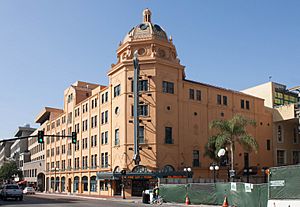
The San Diego Civic Theatre is where the San Diego Opera performs and where many traveling shows come. The San Diego Symphony is based at Jacobs Music Center, which used to be a movie theater built in 1929. The Spreckels Theater has been open since 1912 and hosts many local and traveling shows. The Balboa Theatre, built in 1924, reopened in 2008 after being fixed up for live shows and concerts. Both the Spreckels and Balboa theaters are listed as historic places.
Other theaters downtown include the Lyceum in Horton Plaza, which hosts the San Diego Repertory Theatre. Nightclubs like the House of Blues and Croce's feature well-known music groups. The Museum of Contemporary Art, also downtown, shows art from different types of media.
Filming Locations
Many movies have filmed scenes in Downtown San Diego:
- Anchorman: The Legend of Ron Burgundy showed aerial views of downtown.
- Demolition Man was filmed along Harbor Drive near the San Diego Convention Center.
- Parts of The Samuel Project were filmed in the Gaslamp district.
- Other films include Everybody Dies by the End, Friend of the World, Hacksaw, In God We Tru$t, My Son, My Son, What Have Ye Done? and Scavenger Hunt.
Fun Tourist Attractions
The Columbia (waterfront) neighborhood of downtown has the USS Midway aircraft carrier museum ship. You can also see eight other ships and boats at the Maritime Museum of San Diego, including the famous Star of India.
The San Diego Convention Center and Petco Park are both downtown, as well as Seaport Village. More than 200 cruise ships visit the cruise ship terminal each year. A ferry connects downtown San Diego with Coronado, and you can take boat tours of San Diego Bay from Harbor Drive.
Annual Events
Downtown San Diego hosts many exciting events every year:
- The Big Bay Balloon Parade, which happens with the Holiday Bowl.
- The Martin Luther King Jr. Day Parade and Festival.
- The Parade of Lights, where boats decorated with holiday lights sail on the Bay.
- The San Diego Street Scene music festival.
- Every July, downtown San Diego transforms for San Diego Comic-Con. This is the biggest entertainment and comic book convention in the world. It's held inside the San Diego Convention Center and also uses many nearby hotels, parks, and plazas.
Education
The schools in the downtown area are part of the San Diego Unified School District. Washington Elementary School is located downtown. San Diego High School and San Diego City College are in the northeastern part of downtown, next to Balboa Park. Middle school students from downtown usually go to Roosevelt Middle School in the Balboa Park area.
The charter high school e3 Civic High School is actually inside the downtown library. Monarch School, a public school for students who are homeless, is also located downtown. There are also a few private schools in the area. California Western School of Law is located downtown for college students.
Transportation and Streets
Downtown streets are set up in a grid pattern, and many are one-way. Roads that go north-south have both names and numbers. The named roads start with Harbor Drive and then go east past Pacific Highway, Kettner Boulevard, India, Columbia, State, Union, and Front streets. After that, the roads are numbered and called avenues, from 1st Avenue to Park Boulevard (12th Avenue). Usually, even-numbered streets go south, and odd-numbered streets go north.
East-west streets are named alphabetically from A to K, but D, H, and I are replaced with Broadway, Market Street, and Island Avenue. Streets north of A Street are named after trees, like Ash Street up to Laurel Street.
Main roads include Broadway and Market Street (east-west), and Harbor Drive, Pacific Highway, and Park Avenue (north-south).
Freeways and Public Transit
Three freeways either go through or start/end in downtown San Diego:
- State Route 163 (SR 163) ends downtown. The southbound lane becomes 10th Avenue, and 11th Avenue becomes the northbound lane at Ash Street.
- Interstate 5 (I-5) passes above the downtown area. You can get on it from certain streets outside downtown or where SR 163 starts and ends.
- SR 94 enters downtown from the east. Westbound SR 94 becomes F Street, and G Street becomes eastbound SR 94.
The downtown area is served by the San Diego Metropolitan Transit System, which includes the San Diego Trolley. There's also a commuter train called the Coaster that connects downtown with northern San Diego County and other coastal towns. The Amtrak passenger train system also stops downtown.
Parking downtown is mostly in "pay to park" lots, and there are also metered parking spots along most streets. You can also find parking at the County operation center and at Seaport Village.
Images for kids
See also
 In Spanish: Downtown San Diego para niños
In Spanish: Downtown San Diego para niños


